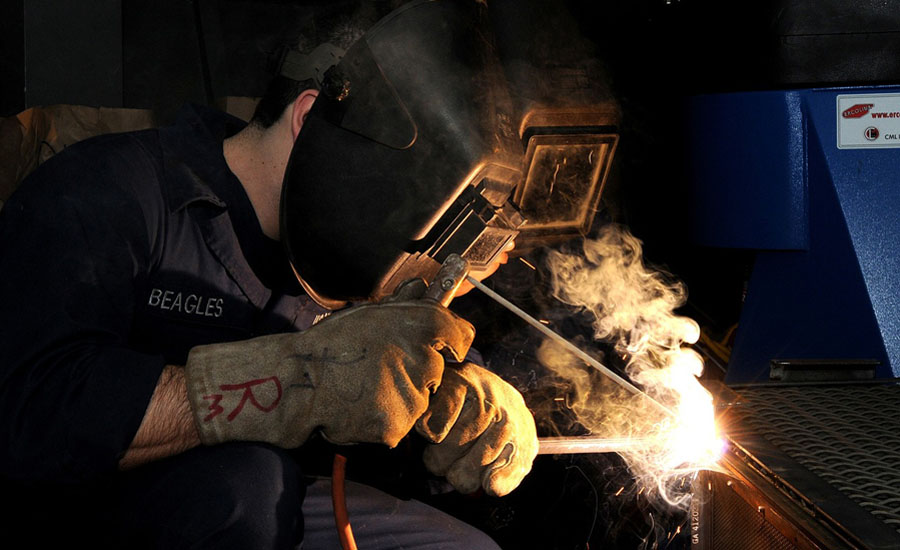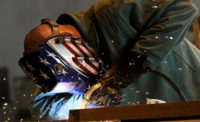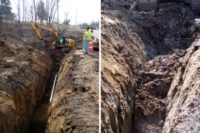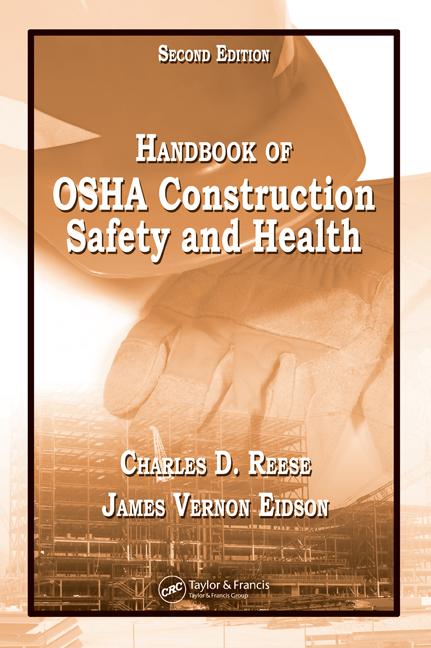General hazards of welding include impact, penetration, harmful dust, smoke, fumes, heat and light radiation.
Welding “smoke” is a mixture of very fine particles (fumes) and gases. Many of the substances in the smoke can be extremely toxic.
The intense heat of welding and sparks can cause burns. Eye injuries have resulted from contact with hot slag and metal chips.
The intense light associated with welding can cause eye damage. Ultraviolet light from an arc can cause “welder’s flash” and also skin burns.
There is also a danger of electric shock. If combustible or flammable materials are nearby, the heat and sparks produced by welding can cause fires or explosions. The use of compressed gas cylinders poses some unique hazards to the welder.
OSHA stresses its three lines of defense philosophy to help eliminate or reduce potential exposures to hazards.
• The first line of defense is to utilize engineering controls to eliminate the hazard. Adding ventilation to reduce air contaminants from a welding operation is an example of an engineering control.
• Administrative controls are the second line of defense. Scheduling the work to limit a welder’s exposure to a hazard is an example of an administrative control.
• Personal protective equipment (PPE) is the last line of defense. Wearing a respirator to limit a welder’s exposure to welding fumes is an example of a PPE control. When properly selected and maintained, PPE can help protect employees from welding hazards.
Welding safety precautions
Before any welding is conducted outside of a designated welding area, a responsible individual must inspect the area and identify precautions to be taken preferably on a written Hot Works permit.
Fire extinguishers must be ready for immediate use.
A fire watch lasting at least 30 minutes after the welding or cutting operations is required if more than a minor fire might develop.
All combustibles must be moved 35 feet away or properly protected or shielded.
Prohibited areas for welding include:
· Areas unauthorized by management
· Areas where sprinklers are impaired
· Areas in explosive atmospheres
· Areas near storage of large quantities of readily ignitable materials
Ventilation
Ventilation refers to changes of room air as often as necessary to prevent welders and other workers from breathing high levels of airborne contaminants. Ventilation is a means of providing adequate breathing air, and it must be provided for all welding, cutting, brazing and related operations. Adequate ventilation depends on the following factors:
· Volume and configuration of the space where the welding operations occur
· Number and type of operations that are generating contaminants
· Natural air flow rate where operations are taking place
· Location of the welders’ and other workers’ breathing zones in relation to contaminants or sources
Proper ventilation can be obtained either naturally or mechanically. Natural ventilation is considered sufficient for welding and brazing operations if the work area meets these requirements:
· Space of more than 10,000 square feet is provided per welder
· A ceiling height of more than 16 feet
· Welding is not done in a confined space
· Welding space does not contain partitions, balconies or structured barriers that obstruct cross ventilation
If your specific operation does not fall within the natural ventilation guidelines, mechanical ventilation will be required.
Mechanical ventilation options generally fall into two basic categories.
The first is a low-vacuum system, which takes large volumes of air at low velocities. This system consists of hoods positioned at a distance from the work area. The hood and housing may have to be repositioned by the worker to get maximum benefit from this means of ventilation. Hoods generally remove the fumes and contaminated air through ducting and exhaust the contaminants to the outdoors. Hoods should be placed as near as practical to the work and should provide effective air flow with a velocity of 100 linear feet (30 meters) per minute at its most remote distance from the point of welding. Processes where low-vacuum systems work best are arc air gouging and arc cutting.
Another category of mechanical ventilation is a high-vacuum system. This system consists of a close-range extractor aimed at capturing and extracting fumes as near to the work as possible. Fume extractors often have an immediate area of welding. By removing a small volume of air at a high velocity, the potentially hazardous materials are effectively removed before reaching the welder’s breathing zone. These systems often are equipped with a fan that pulls the contaminants into a filtration system, with a high-efficiency particulate absolute (HEPA) filter or combination of HEPA filter and prefilter and then recirculates the clean air back into the work area. Advantages of high-vacuum systems are greater flexibility for job adaptation, more efficient means of fume removal and greater visibility to the welder due to reduced clouds of fumes and vapors being created.
Fumes and gases from welding and cutting cannot be easily classified. The quantity of fumes and gases is relative to the metal being worked and the processes and consumable material being used, such as coatings (like paint, galvanizing and platings), along with contaminants in the atmosphere, such as halogenated hydrocarbon vapors from cleaning and degreasing activities. Air sampling to verify the concentration levels of toxic fumes and gases is necessary. Respiratory protection is required along with mechanical ventilation in the cutting and/or welding of certain metals and compounds. For more information, see OSHA 29 CFR 1910.252 on welding regulations.
Source: W.W. Grainger






